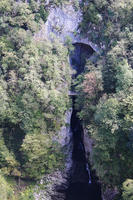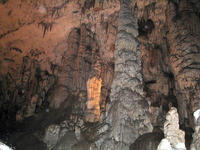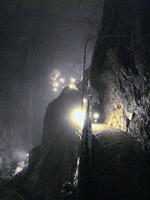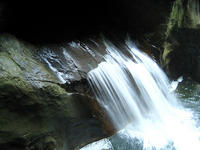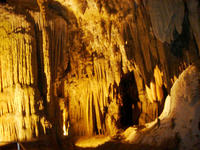You are in: Europe -> Slovenia -> Škocjan Caves, and traditional search or Image Gallery will yield results of this site only
Škocjan Caves
| Site number: | 390 |
|
| Type of site: | Natural | |
| Date of Inscription: | 2007 | |
| Location: | Europe, Slovenia, Region of Obalno-kraška, Villages of Škocjan pri Divaci, Matavun and Betanja | |
Up to 75 images are shown here. Click on each for more details or on Image Gallery for more images.
| Description: | Underground passages stretching 6 km with a total depth of more than 200 m are nestle within this extraordinary system of limestone caves that encompasses collapsed dolines, also holding numerous waterfalls and one of the biggest known underground chambers. Located in the Kras region (literally meaning Karst), the site is among the world’s most eminent for the study of karstic phenomena. --WHMNet paraphrase from the description at WHC Site, where additional information is available. | |
| Škocjan Caves (Slovene Škocjanske jame; Italian: Grotte di San Canziano) is a system of limestone caves in the Kras (Karst) region in southwestern Slovenia, containing collapsed dolines, about 5 kilometres of underground passages, caves more than 200 metres deep and many waterfalls. This is one of the most famous sites in the world for the study of karstic (limestone) phenomena. Since 1986, Škocjan Caves are on the UNESCO list of World Heritage Sites. The Reka River disappears underground in Velika dolina into Skocjan Caves Park (Škocjanske jame) and then flows underground for 34 km, all the way to Adriatic Sea where it becomes the source of the Timav River. The view of the big river, in the rainy season as it disappears underground, on the bottom of Velika dolina, 160 m under the surface, is both majestic and frightening. The region of the Skocjan Caves Park, is archeologically extremely rich, indications are that it was inhabited since more than ten thousand years before the present. A precious treasure of archeological findings in 'Mušja Jama' indicate the influence of the Greek civilization, where since the end of the Bronze Age and in the Iron Age a cave temple was located. This region was certainly one of the most significant pilgrimage sites in Europe, three thousand years ago, especially in the Mediterranean where it was of important cult significance in connection with the afterlife and communication with the spirits of the ancestors. --Wikipedia. Text is available under the Creative Commons Attribution-ShareAlike License. | ||
| Source: | http://whc.unesco.org/en/list/390 | |
| Reference: | 1. UNESCO World Heritage Center, Site Page. | |




